Marine and freshwater
Each year the Northland Regional Council receives reports from the public of poor water quality in marine and freshwater environments. A lot of these reports are due to actual pollution incidents, but sometimes they are a result of naturally occurring phenomena.
These natural phenomena are often very obvious – they can be brightly coloured and smelly – however they generally don't cause any adverse environmental effects.
The phenomena may be caused by real pollution incidents, which we need to know about. If you see any of these, please call our 24/7 Environmental Hotline 0800 504 639 so we know where they are.
Algal and plankton blooms
Blooms are caused by sudden, massive growths of naturally occurring, microscopic plant and animal life – both algae and plankton. This often causes discolouration of both fresh and salt water.
They can be mistaken for oil slicks, sewage overflows or paint spills and they can occur extensively over the summer period and come in many colours, from bright red and orange to browns and greens.
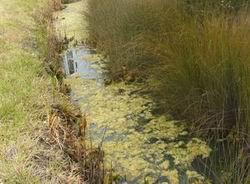
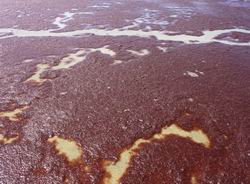
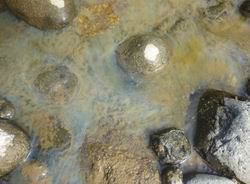
Iron-oxide bacteria
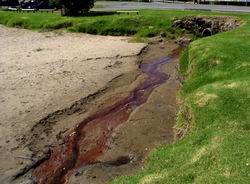
Iron-oxide bacteria use iron present in the water or earth in their metabolic processes. The bacterial breakdown produces iron-oxide deposits: a bright orange, fuzzy growth.
Iron-oxide bacteria often occur in iron-rich water, groundwater seeps and during low water flows. It can often be seen in streams or at stormwater outfalls and is non-toxic and not necessarily associated with pollution.
Dead fish
Many naturally-occurring phenomena, such as low flows and temperature increases can cause oxygen levels in streams and rivers – which may also be influenced by estuaries – to decrease significantly. This decrease can drop to a level where the stream can no longer support life. This will cause fish to suffocate and eventually die.
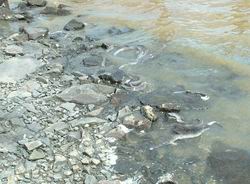

Natural surface scum or sheens
Natural scum/foams
Natural scum is an oily, brown film that accumulates in streams, normally behind stream obstructions – like logs and other debris. This scum is mostly organic and normally representative of generally poor stormwater quality and usually contains general debris. Natural foams can be brown or white and also accumulate behind stream obstructions.
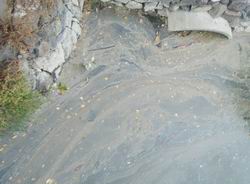
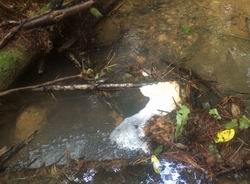
Sea foam
Sea foam occurs around mangroves and in surf. It is generally a light brown/creamy colour and can look a lot like a diesel scum or oily layer. It often has an organic smell.
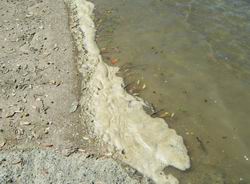
Smelly mud
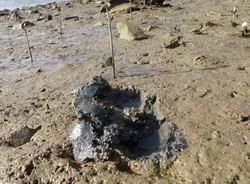
Marine mud, below a very thin brownish layer of sediment, is often black and smells of rotting eggs. It is natural, non-toxic and often found in and around mud flats and mangroves.
Pollen
Pollen is common throughout Northland particularly in late winter and early spring when it falls from plants – pine pollen is a common cause. Pollen looks like dustings of powdered sulphur but is easily identified by its lack of smell. Large amounts of pollen on streams and lakes can also be mistaken for paint spills.
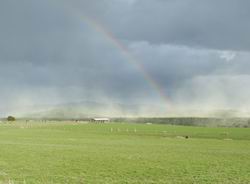
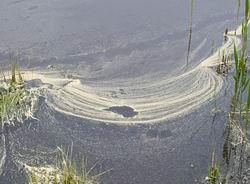
Rotting vegetation
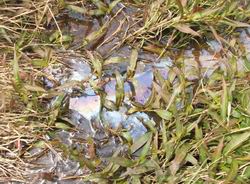
Rotting vegetation often produces a rainbow-like sheen that can be mistaken for an oil slick. This can be relatively easily identified by breaking up the sheen with a stick or something similar – while an oil sheen will swirl, elongate and reform, the organic sheen tends to break into irregular rafts with a mirror-like appearance.
Stagnant streams
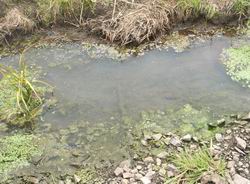
Stagnant streams often occur in the summer – they appear black and are smelly. They are caused by micro-organisms in the water which use up all the oxygen. They happen when there's low rainfall and often when a buildup of sand at a stream-mouth, or rotting vegetation blocks water flow, or with slow draining flood waters.
Rotting seaweed and Algae
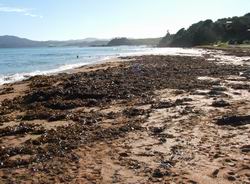
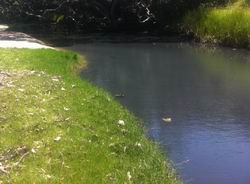
Rotting seaweed and algae is deposited along the shoreline in some weather conditions, and can also get deposited in coastal streams. It can have a strong, unpleasant smell and appear black and slimy. It may sometimes also produce a white liquid discharge and be mistaken for sewage.
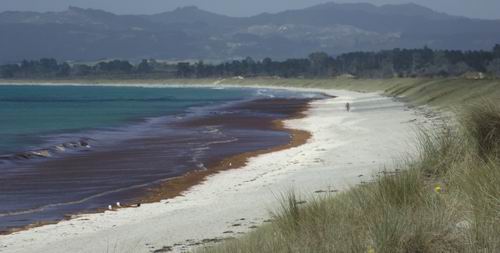
Seaweed can wash up along the shore during certain weather conditions.
